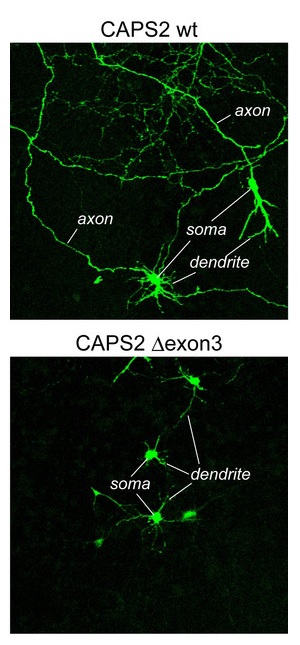Jun. 29, 2007 Research Highlight Biology
Pinpointing genetic lesions of autism
New work links autism with defects in the sequence of a gene expressed in the brain
 Figure 1: Normal CAPS2 protein (CAPS2 wt) is transported through the axon of neocortical neurons (upper), whereas shorter protein (CAPS2 Δexon3) is not (lower).
Figure 1: Normal CAPS2 protein (CAPS2 wt) is transported through the axon of neocortical neurons (upper), whereas shorter protein (CAPS2 Δexon3) is not (lower).
A recent study establishes a causative relationship between a single gene and susceptibility to autism, a relatively prevalent neurological disorder characterized by impaired social and communicative behavior. Much work indicates that a strong genetic component underlies autism susceptibility. Although genetic mapping studies identified an autism susceptibility region on human chromosome 7, whether specific genes located within this region are associated with autism is not known.
A team led by Teiichi Furuichi, a scientist at RIKEN’s Brain Science Institute in Wako, sought to determine whether CADPS2, a gene within this region, influences autism susceptibility. This work by Tetsushi Sadakata, a researcher of his team, and his colleagues was published in a recent issue of the Journal of Clinical Investigation 1.
CADPS2 (also called CAPS2) encodes a protein that regulates the trafficking and release, or exocytosis, of vesicles containing cargo such as neurotrophic factors, which influence brain cell maturation and survival. To determine whether the absence of CADPS2 influences autism development, the researchers generated mice carrying a disrupted version of CADPS2.
The mutant mice exhibited normal visual, auditory, olfactory and motor function, all of which are normal in autistic patients. However, like autistic humans, CADPS2-deficient mice engaged in fewer social interactions with other mice, displayed heightened anxiety and reduced exploration in unfamiliar environments, and were hyperactive even in familiar surroundings.
Absence of CADPS2 resulted in cellular defects mirroring those frequently observed in the brains of autistic patients, such as reduced development and impaired survival of certain varieties of brain cells including some GABAergic interneurons and cerebellar Purkinje cells. Provision of brain-derived neurotrophic factor (BDNF), a protein found in CADPS2-associated vesicles in normal mice, rectified these cellular abnormalities.
Notably, some autistic but no healthy patients expressed a mutated shorter version of CADPS2. Like full-length CADPS2, this mutant CADPS2 protein promoted the secretion of BDNF. However, only full-length CADPS2 bound to the dynactin complex, which regulates the transport of vesicles through the axon, a specific region within brain cells. Accordingly, full-length but not mutant CADPS2 was found within the axons of brain cells (Fig. 1).
Not all autistic patients examined in the study exhibited mutations in CADPS2, and the cause why the shorter CADPS2 is produced remains unknown. Nevertheless, these findings highlight a specific gene that might contribute to the development and/or pathology of autism.
“These results provide a clue that might aid in the development of early diagnostic tests for autism and therapies effective in treating autism,” says Furuichi.
References
- 1. Sadakata, T., Washida, M., Iwayama, Y., Shoji, S., Sato, Y., Ohkura, T., Katoh-Semba, R., Nakajima, M., Sekine, Y., Tanaka, M., et al. Autistic-like phenotypes in Cadps2-knockout mice and aberrant CADPS2 splicing in autistic patients. Journal of Clinical Investigation 117, 931–943 (2007). doi: 10.1172/JCI29031
